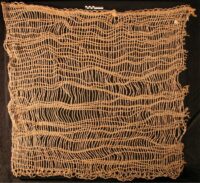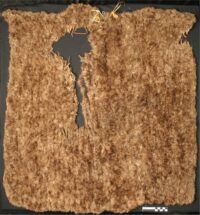A new study published in the Journal of Archaeological Science: Reports has  found that the Ancestral Pueblo people of the Southwest used more than 11,000 feathers from four to 10 turkeys to make a single 3’3″x 3’6″ blanket. The study used a yucca fiber blanket framework on display at the Edge of the Cedars State Park Museum in Blanding, Utah, as a template. Its feathers have been lost to insect activity but the rachises of which remain in the yucca warp cords. Analysis of the featherless blanket framework and a second, smaller blanket with intact feathers dating to the 1200s concluded that the framework would have had 11,550 feathers when intact. The number of turkeys necessary to collect this many feathers was estimated by examining the pelts of adult wild turkeys which are comparable anatomically to the extinct domestic turkey of the Ancestral Pueblo.
found that the Ancestral Pueblo people of the Southwest used more than 11,000 feathers from four to 10 turkeys to make a single 3’3″x 3’6″ blanket. The study used a yucca fiber blanket framework on display at the Edge of the Cedars State Park Museum in Blanding, Utah, as a template. Its feathers have been lost to insect activity but the rachises of which remain in the yucca warp cords. Analysis of the featherless blanket framework and a second, smaller blanket with intact feathers dating to the 1200s concluded that the framework would have had 11,550 feathers when intact. The number of turkeys necessary to collect this many feathers was estimated by examining the pelts of adult wild turkeys which are comparable anatomically to the extinct domestic turkey of the Ancestral Pueblo.
The feathers offered better insulation than the twined strips of cottontail rabbit fur that preceded them as the preferred material among prehistoric foragers in the west, and had the added advantage of sustainability, as feathers can be harvested regularly without requiring the demise of their donor. They are also more durable than rabbit skins. Turkey feather blankets became so widespread in the Pueblo communities that researchers estimate that households had a turkey feather wearing blanket, bed blanket or funerary wrapping for each member of the family, adult and child from the Basketmaker II period into the 19th century when Pueblo turkey farming disappeared under Spanish occupation.
 Blankets, mantles and robes lined with turkey feathers were highly valued objects in the Ancestral Pueblo communities of Colorado, Utah, New Mexico, and Arizona (known as the Upland Southwest). These communities were at high altitudes where winters were cold and even summers were cool at night. Blankets made of turkey feathers and plant fiber cords began to appear in the Basketmaker II period (400 B.C. – 500 A.D.) when the cultivation of maize as the base of their diet drove groups to build permanent settlements. The earliest evidence of domestication of turkeys in the Upland Southwest communities date to the first two centuries, but they didn’t become a major food source until the 12th century.
Blankets, mantles and robes lined with turkey feathers were highly valued objects in the Ancestral Pueblo communities of Colorado, Utah, New Mexico, and Arizona (known as the Upland Southwest). These communities were at high altitudes where winters were cold and even summers were cool at night. Blankets made of turkey feathers and plant fiber cords began to appear in the Basketmaker II period (400 B.C. – 500 A.D.) when the cultivation of maize as the base of their diet drove groups to build permanent settlements. The earliest evidence of domestication of turkeys in the Upland Southwest communities date to the first two centuries, but they didn’t become a major food source until the 12th century.
Blanket feathers were probably most frequently collected from live birds, although natural molts or recently killed birds may have contributed.
This would have allowed sustainable collection of feathers several times a year over a bird’s lifetime, which could have exceeded 10 years.
“When the blanket we analyzed for our study was made, we think in the early 1200s CE, the birds that supplied the feathers were likely being treated as individuals important to the household and would have been buried complete,” Professor Lipe said.
“This reverence for turkeys and their feathers is still evident today in Pueblo dances and rituals. They are right up there with eagle feathers as being symbolically and culturally important.”
The study, Staying warm in the upland southwest: A “supply side” view of turkey feather blanket production, can be read in its entirety here.